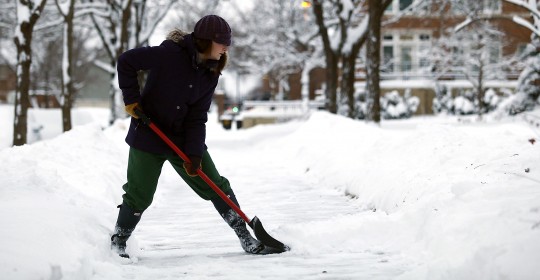
Tips for Shoveling Snow: How to Avoid Injury
Shoveling snow is one of the most common causes of injury to the low back and shoulders during the winter months. It is also the cause of a few hundred heart attacks each year. The cold weather, increased exertion and slippery surfaces that those shoveling snow are presented with is a dangerous combination especially when it is an activity that the body is not used to doing. Shoveling snow is noted as one of the most high intensity exercises that you can do, as you are using all the major muscle groups to perform the activity. A shovel full of snow can weigh anywhere from 5-7 pounds, and repetitively lifting that amount over time can increase your chance of injury.
Here are a few tips you can follow to shovel safely and get through the winter injury free!
- Warm up: before heading out into the snow, a 5-10 minute warm up is beneficial prior to starting a strenuous activity. A brisk walk or marching on the spot is all you need to slowly elevate your heart rate and prepare your muscles for more activity!
- Don’t let the snow pile up: frequent shoveling allows you to move smaller amounts of snow at once which decreases the weight of the shovel and lowers your chance of strain on the low back or shoulders.
- Pick the right shovel: the more lightweight the better! Shovels that have a bend in the arm of the shovel are better when lifting is needed as it helps you to maintain a more straight or neutral spine, and you don’t have to bend over as far.
- Push, don’t throw: push snow to the side rather than throwing it. This helps to avoid lifting heavy amounts of snow with sudden twisting or turning movements which puts you at increased risk for muscle strain or disc herniation.
- Bend your knees: if you have to lift the snow, use your leg and arm muscles to do the lifting while maintaining a straight back (as mentioned in tip #3). Bending your knees and lifting by push up with your legs rather than bending at the waist and lifting with your back is going to protect you from injury.
- Take a break: if you feel tired or short of breath, stop and take a rest. Shake out your arms and legs. If you have back pain that is severe or that persists for more than a day after shoveling, see a chiropractor. If you have chest pain that is severe, see a medical doctor immediately!
- Stay hydrated: just because it is cold out, does not mean you do not need to drink water. Your active body needs plenty of fluids even though it’s cold outside. Keep a water bottle handy outside with you and be sure to drink a lot of it!
- Wear the right boots: try to wear boots that have a tread on them. This will increase the stability you have under your feet. If your feet slip, it throws off your entire balance increasing your risk of injury.
- Layer warm clothing: being cold can also put you at risk for a muscle strain injury. Wear clothing that keeps your muscles warm and wicks away sweat so you don’t get chilled
- The more the merrier: if possible, have the whole family help out! The job can be done much quicker, with each person having to shovel less snow. Plus, it’s a lot more fun!
Leave a reply →




